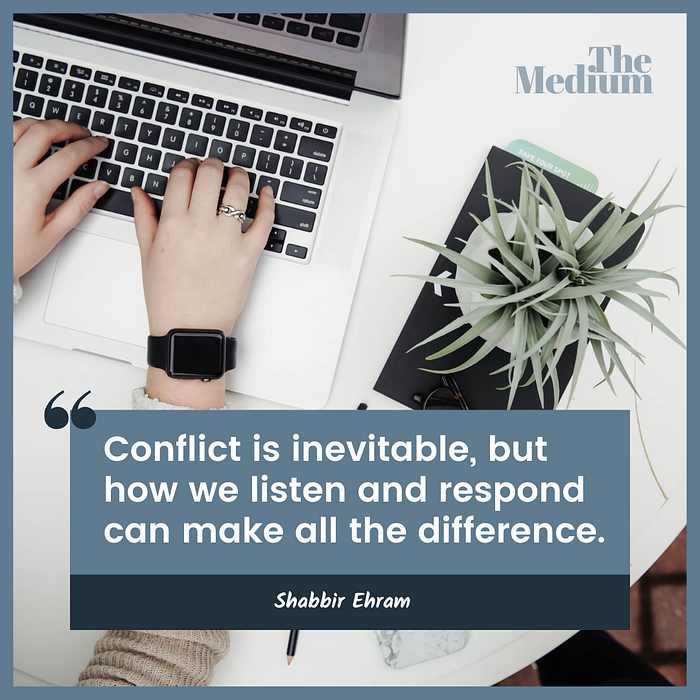Communication Breakdown: Why Listening is Essential in Corporate Conflict Resolution
Communication Breakdown: Why Listening is Essential in Corporate Conflict Resolution
by Shabbir Ehram | Corporate Trainer, Writer
Conflict is a part of life and can arise in various situations, whether it is at home, work, or in social settings. Conflicts can be challenging and unpleasant, and it can be difficult to find a solution that satisfies all parties involved. However, one essential skill that can help in conflict resolution is listening.
Listening is the act of paying attention to another person’s words and understanding their perspective. Effective listening involves focusing on what the other person is saying, acknowledging their feelings, and asking questions to clarify their statements. It is not merely hearing the words, but also interpreting the meaning behind them.
In conflict situations, listening plays a vital role in finding a solution that is acceptable to all parties involved. When people are in conflict, they often feel that their viewpoint is the only valid one. They may not be open to hearing the other person’s perspective, and this can escalate the conflict further. However, by listening actively, individuals can understand the other person’s point of view and recognize the underlying issues that have led to the conflict.
Listening also helps to build trust between people in conflict. When one person feels heard and understood, they are more likely to reciprocate the same behavior. This, in turn, creates an environment of mutual respect and empathy, which is crucial in conflict resolution. When people feel respected, they are more willing to cooperate, compromise, and find a mutually acceptable solution.
Furthermore, listening also helps to identify the emotions that underlie the conflict. In many cases, conflicts arise due to underlying emotional issues that have not been expressed or addressed. By listening attentively, people can identify these emotions and deal with them in a constructive manner.
In corporate environments, conflicts are common, and they can arise between employees, departments, and even between management and employees. These conflicts can lead to poor morale, low productivity, and loss of valuable talent. In such scenarios, effective listening plays a crucial role in conflict resolution and can help organizations maintain a positive work environment.
Active listening involves paying attention to another person’s words, understanding their perspective, and acknowledging their emotions. By listening actively, individuals in corporate settings can better understand the issues at hand, build trust, and work together to find solutions that satisfy everyone involved.
One of the most significant benefits of listening in corporate settings is the ability to build trust. When employees feel that their opinions are heard and valued, they are more likely to be engaged, committed, and willing to work towards a common goal. This, in turn, leads to a more cohesive and productive work environment.
Furthermore, listening helps individuals in corporate settings to better understand the root causes of conflicts. Often, conflicts arise due to misunderstandings, differing opinions, or unaddressed concerns. By listening actively, individuals can identify these underlying issues and work to address them constructively. This approach can lead to more effective conflict resolution, as well as more productive and positive working relationships.
In addition, listening can help organizations identify potential problems before they escalate. By encouraging open communication and active listening, management can gain insights into the concerns and issues of employees. This information can help organizations take proactive measures to prevent conflicts and improve the work environment.
In conflict situations, there are several things to keep in mind to effectively use listening as a tool for conflict resolution. Here are a few important considerations:
- Stay Calm: When dealing with a conflict, it is essential to remain calm and composed. Conflict situations can be emotionally charged, and it is easy to get caught up in the moment. However, getting angry or defensive can escalate the situation and make it harder to resolve. By staying calm, individuals can listen actively and respond constructively.
- Practice Active Listening: Active listening involves paying attention to what the other person is saying, understanding their perspective, and acknowledging their emotions. It is important to listen without interrupting, to show empathy, and to ask clarifying questions to gain a deeper understanding of the situation.
- Avoid Judging or Blaming: In a conflict situation, it is easy to judge or blame the other person. However, this can make the other person defensive and escalate the conflict. Instead, it is important to listen actively, acknowledge the other person’s perspective, and focus on finding a mutually acceptable solution.
- Look for Common Ground: When dealing with a conflict, it is important to look for common ground. This involves identifying shared goals or interests and working towards a solution that satisfies both parties. By focusing on common ground, individuals can find a solution that is acceptable to everyone involved.
- Communicate Effectively: Effective communication is key in conflict resolution. This involves being clear, concise, and respectful in the way one speaks to others. It is important to express oneself in a way that is assertive but not aggressive.
By keeping these considerations in mind, individuals can use listening as a tool for conflict resolution and create a positive and productive work environment.
Dos:
- Listen actively: Active listening involves paying attention to what the other person is saying, acknowledging their emotions, and asking questions to clarify their statements. This helps to build trust and understanding between the parties involved.
- Show empathy: Empathy is the ability to understand and share the feelings of another person. By showing empathy, you can better understand the other person’s perspective and emotions, which can help to resolve the conflict.
- Identify the underlying issues: Often, conflicts arise due to underlying emotional issues that have not been expressed or addressed. By listening attentively, you can identify these issues and deal with them in a constructive manner.
- Be open to compromise: Compromise is an essential element of conflict resolution. By being open to compromise, you can find a mutually acceptable solution that satisfies all parties involved.
- Seek common ground: It can be helpful to find areas of agreement or common ground that can serve as a starting point for resolving the conflict.
Don’ts:
- Don’t interrupt: Interrupting the other person can make them feel unheard and can escalate the conflict further. Allow them to express their viewpoint and listen attentively.
- Don’t be defensive: Being defensive can prevent you from hearing the other person’s perspective and can lead to further conflict. Instead, try to remain calm and open-minded.
- Don’t blame others: Blaming others for the conflict can make them feel defensive and can escalate the conflict further. Instead, focus on finding a solution that satisfies all parties involved.
- Don’t ignore emotions: Emotions play a significant role in conflict resolution. Ignoring them can lead to unresolved emotional issues that can cause the conflict to reoccur.
- Don’t rush the process: Conflict resolution takes time and patience. Rushing the process can lead to an unsatisfactory resolution or cause the conflict to escalate further.
A Conflict Between Two Departments in a Tech Company
John is a project manager in a tech company called TechLeap, responsible for the development of a new software product. The development team is led by Sarah, who has been with the company for several years and is highly skilled in software engineering. However, Sarah’s team has been missing deadlines, causing delays in the project’s launch. John has been under pressure from the upper management to speed up the project, and he is concerned about the impact of the delays on the company’s bottom line.
One day, John confronts Sarah about the missed deadlines and demands an explanation. Sarah becomes defensive and insists that her team has been working hard, but they are facing technical issues that are beyond their control. John, frustrated with the lack of progress, accuses Sarah of not doing enough to manage her team and suggests that she doesn’t have the necessary skills to lead the project.
Sarah, feeling attacked and undervalued, decides to escalate the conflict to the Human Resources (HR) department, and she files a complaint against John for his behavior. The HR department decides to intervene and sets up a meeting between John and Sarah to resolve the conflict.
At the meeting, the HR representative encourages John to listen to Sarah’s perspective and understand her team’s technical challenges. John agrees to listen to Sarah’s concerns and asks her to elaborate on the technical issues her team is facing. Sarah explains that her team has been struggling with a new software development platform, and they require additional training and resources to overcome the challenges.
John, realizing that he has been too harsh on Sarah, apologizes for his behavior and offers to provide additional resources to support her team. He also agrees to work collaboratively with Sarah to find a solution that addresses the technical challenges while keeping the project on track.
Learning Outcomes:
- The importance of active listening: The HR representative’s intervention was critical in getting John to listen to Sarah’s perspective and understand the challenges her team was facing. Active listening helped to establish trust between the parties and enabled them to find a common ground.
- The value of empathy: John’s initial response was defensive, which escalated the conflict further. By showing empathy towards Sarah’s situation, he was able to gain a better understanding of the technical challenges her team was facing and work collaboratively towards a solution.
- The need for open communication: Communication is critical in conflict resolution. John and Sarah’s willingness to communicate openly and honestly about their concerns and challenges helped to find a solution that worked for both parties.
- The importance of finding a common ground: Conflict resolution is about finding a mutually acceptable solution that satisfies all parties involved. By working collaboratively and finding common ground, John and Sarah were able to find a solution that addressed the technical challenges while keeping the project on track.

When you find yourself in a situation where the other person in a corporate conflict is not willing to listen to you, it can be challenging to resolve the issue. However, there are some strategies you can try:
- Take a step back: It’s essential to take a step back and assess the situation before taking any action. Sometimes, emotions can get in the way of clear thinking, and it’s better to approach the situation with a clear mind.
- Be respectful: Even if the other person is not listening to you, it’s important to remain respectful and maintain a professional demeanor. Avoid using a confrontational or aggressive tone, as it may only escalate the conflict.
- Find a mediator: If you feel that you cannot communicate effectively with the other person, consider involving a neutral third-party mediator. This person can help to facilitate communication between the two parties and work towards finding a mutually acceptable solution.
- Document the issue: If the conflict persists, it’s essential to document the issue in writing, including the details of the conflict, the actions taken, and any outcomes. This documentation can be helpful if the issue needs to be escalated to a higher authority, such as HR or a supervisor.
- Seek support: If the conflict is causing stress or affecting your work performance, it’s important to seek support from your supervisor or HR. They may be able to provide guidance or assistance in resolving the conflict.
Ultimately, if the other person is not willing to listen, you may need to accept that the conflict may not be resolved. In this case, it’s important to focus on finding a way to work productively with the other person and minimize any negative impact on your work.
What to do when we see two people have a conflict and when we try to solve it, they have a conflict with us?
When attempting to resolve a conflict between two other people, it’s important to approach the situation with care and sensitivity. If the individuals involved in the conflict become defensive or turn their anger towards you, it can be challenging to resolve the issue. Here are some strategies you can try:
- Stay neutral: When trying to resolve a conflict between two other people, it’s important to remain neutral and avoid taking sides. Remain objective and focused on finding a mutually acceptable solution that benefits both parties.
- Listen actively: Active listening is a key component of conflict resolution. Listen carefully to both parties and make sure that each person feels heard and understood.
- Ask open-ended questions: Open-ended questions can help to encourage communication and clarify misunderstandings. Ask questions that promote dialogue and understanding.
- Use “I” statements: Using “I” statements instead of “you” statements can help to deescalate the situation and avoid causing defensiveness. For example, say “I understand that you’re upset, and I want to help find a solution” instead of “You’re being unreasonable.”
- Don’t force a solution: It’s essential to recognize that not all conflicts can be resolved, and it’s not your responsibility to force a solution. If the individuals involved are not willing to work towards a solution, it may be necessary to involve a neutral third party or escalate the issue to a higher authority.
- Know your limits: It’s important to recognize when a conflict is beyond your capacity to resolve. If you feel uncomfortable or unsafe, remove yourself from the situation and seek help from a supervisor, HR, or a trained mediator.
In summary, when attempting to resolve a conflict between two other people, it’s important to remain neutral, listen actively, ask open-ended questions, use “I” statements, avoid forcing a solution, and know your limits. These strategies can help you to navigate challenging situations and work towards a mutually acceptable resolution.
The role of listening in conflict resolution cannot be overstated. By actively listening to others and showing empathy and understanding, we can diffuse tense situations, build better relationships, and find solutions that work for everyone involved. While it may take time and effort to master the art of listening, the benefits are well worth it, both in our personal lives and in the corporate world.

If you have any questions or would like to share your experiences with conflict resolution, please feel free to reach out to me at shabbir.ehram@gmail.com. I would be more than happy to hear from you.
Remember, conflict is a natural part of human interaction, but by using effective listening skills, we can turn conflicts into opportunities for growth and learning. So let’s listen up and work together towards a more peaceful and productive corporate environment.






Comments
Post a Comment